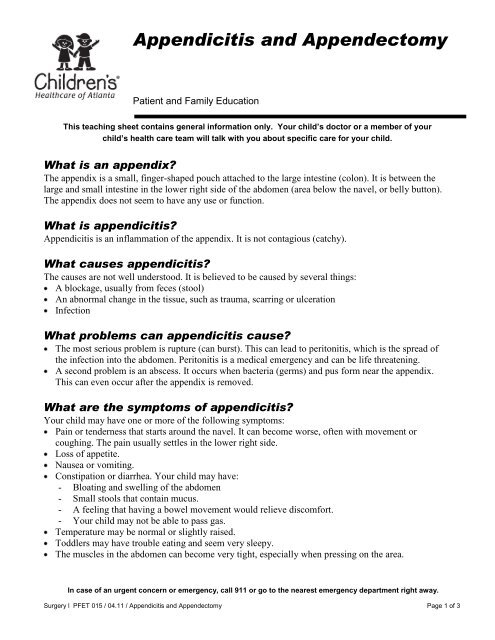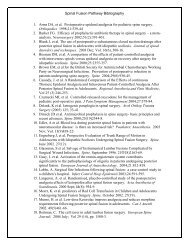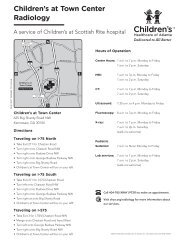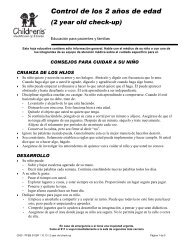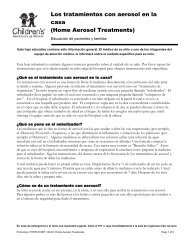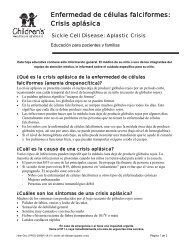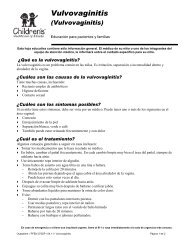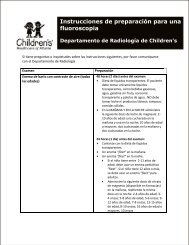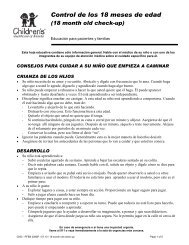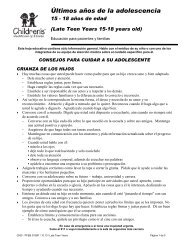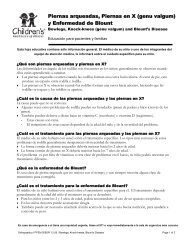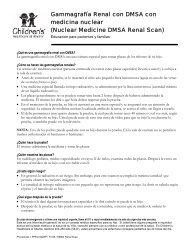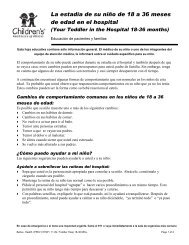Appendicitis and Appendectomy
Appendicitis and Appendectomy
Appendicitis and Appendectomy
You also want an ePaper? Increase the reach of your titles
YUMPU automatically turns print PDFs into web optimized ePapers that Google loves.
<strong>Appendicitis</strong> <strong>and</strong> <strong>Appendectomy</strong><br />
Patient <strong>and</strong> Family Education<br />
This teaching sheet contains general information only. Your child’s doctor or a member of your<br />
child’s health care team will talk with you about specific care for your child.<br />
What is an appendix?<br />
The appendix is a small, finger-shaped pouch attached to the large intestine (colon). It is between the<br />
large <strong>and</strong> small intestine in the lower right side of the abdomen (area below the navel, or belly button).<br />
The appendix does not seem to have any use or function.<br />
What is appendicitis?<br />
<strong>Appendicitis</strong> is an inflammation of the appendix. It is not contagious (catchy).<br />
What causes appendicitis?<br />
The causes are not well understood. It is believed to be caused by several things:<br />
A blockage, usually from feces (stool)<br />
An abnormal change in the tissue, such as trauma, scarring or ulceration<br />
Infection<br />
What problems can appendicitis cause?<br />
The most serious problem is rupture (can burst). This can lead to peritonitis, which is the spread of<br />
the infection into the abdomen. Peritonitis is a medical emergency <strong>and</strong> can be life threatening.<br />
A second problem is an abscess. It occurs when bacteria (germs) <strong>and</strong> pus form near the appendix.<br />
This can even occur after the appendix is removed.<br />
What are the symptoms of appendicitis?<br />
Your child may have one or more of the following symptoms:<br />
Pain or tenderness that starts around the navel. It can become worse, often with movement or<br />
coughing. The pain usually settles in the lower right side.<br />
Loss of appetite.<br />
Nausea or vomiting.<br />
Constipation or diarrhea. Your child may have:<br />
- Bloating <strong>and</strong> swelling of the abdomen<br />
- Small stools that contain mucus.<br />
- A feeling that having a bowel movement would relieve discomfort.<br />
- Your child may not be able to pass gas.<br />
Temperature may be normal or slightly raised.<br />
Toddlers may have trouble eating <strong>and</strong> seem very sleepy.<br />
The muscles in the abdomen can become very tight, especially when pressing on the area.<br />
In case of an urgent concern or emergency, call 911 or go to the nearest emergency department right away.<br />
Surgery l PFET 015 / 04.11 / <strong>Appendicitis</strong> <strong>and</strong> <strong>Appendectomy</strong> Page 1 of 3
<strong>Appendicitis</strong> <strong>and</strong> <strong>Appendectomy</strong>, continued<br />
What medical tests may my child have?<br />
Some tests that might be helpful to your child’s doctor include:<br />
Blood tests - blood tests alone cannot confirm appendicitis, but an increase in the WBC (white blood<br />
cell) count may point to it.<br />
A routine urine test<br />
X-Ray, ultrasound exam or CT scan of the abdomen may help to show an inflamed appendix.<br />
What is the treatment for appendicitis?<br />
There is no known medical treatment for appendicitis – surgery is needed. Your child’s doctor will talk<br />
with you about specific care for your child. Some general guidelines to follow include:<br />
An appendectomy is an operation to remove the appendix. It can be done in two different ways,<br />
depending on your child’s condition:<br />
- Laparoscopy – this is a type of surgery where 3 or 4 small incisions are made in the abdomen to<br />
remove the appendix. A lighted tube with a camera on the end (called a laparoscope) is used to<br />
check the area. Special instruments are used to remove the appendix. Your child can usually go<br />
home within a day after this type of surgery.<br />
- Open incision - a larger incision is made on the lower, right side of the abdomen. If an abscess<br />
or peritonitis has occurred, the area is “washed” well after the appendix is removed. Your child<br />
can usually go home within a day or two after this type of surgery.<br />
Surgery is done using general anesthesia, so your child will be in a deep sleep. He will not feel pain<br />
during the surgery.<br />
Other treatments may include:<br />
- Antibiotics (medicines to kill germs).<br />
- Intravenous (IV or in the vein) fluids.<br />
- Drain tubes left in place after surgery to drain fluids from the abdomen.<br />
- Medicines for pain.<br />
- Getting out of bed as soon as he is able. Walking helps the lungs stay clear <strong>and</strong> helps get rid of<br />
excess gas in the abdomen.<br />
What is the treatment for a ruptured appendix?<br />
A ruptured appendix usually requires more treatment.<br />
Antibiotics may be needed for a longer time.<br />
Your child may also need a nasogastric (NG) tube connected to suction. An NG tube is a long, soft,<br />
flexible tube placed in the nose, down the throat <strong>and</strong> into the stomach. It is usually kept in place for<br />
several days until normal bowel function returns.<br />
What is the treatment for an abscess?<br />
Sometimes patients are sent home on antibiotics to clear up the infection before surgery is done. A<br />
drainage tube may be left in place during this time.<br />
When can my child return to daycare, school or work?<br />
Your child’s doctor will tell you when your child can return to normal activities. Your child may need<br />
to:<br />
Rest at home for a week or two.<br />
Refrain from strenuous activities such as gym class, sports or heavy lifting for about a month.<br />
In case of an urgent concern or emergency, call 911 or go to the nearest emergency department right away.<br />
Surgery l PFET 015 / 04.11 / <strong>Appendicitis</strong> <strong>and</strong> <strong>Appendectomy</strong> Page 2 of 3
<strong>Appendicitis</strong> <strong>and</strong> <strong>Appendectomy</strong>, continued<br />
When should I call the doctor?<br />
Call your child’s doctor right away if your child has any of the following:<br />
Fever over 101 0 F<br />
Signs of infection in the incision area such as:<br />
- Redness<br />
- Swelling<br />
- Increased drainage or bleeding<br />
- Increased pain<br />
Also call your child’s doctor for:<br />
Pain not relieved by his pain medicine<br />
Any questions or concerns you have about how your child looks or feels.<br />
In case of an urgent concern or emergency, call 911 or go to the nearest emergency department right away.<br />
Surgery l PFET 015 / 04.11 / <strong>Appendicitis</strong> <strong>and</strong> <strong>Appendectomy</strong> Page 3 of 3


